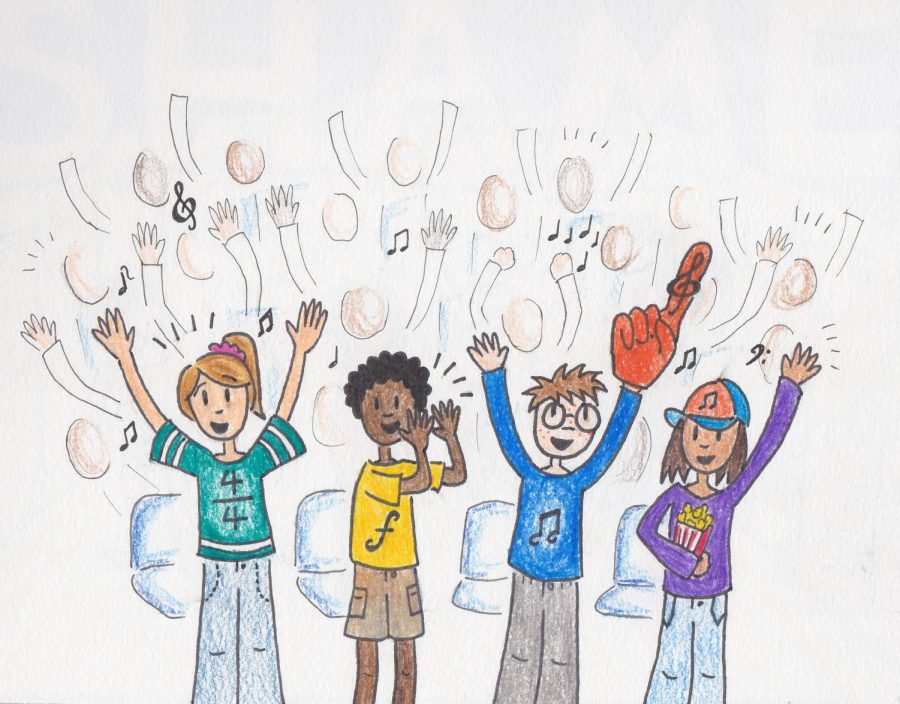Performing artists deserve the same support as athletes
November 19, 2018
It is the homecoming game. The bleachers are packed; there are lines outside the gates of the field. Fans – students, teachers, friends and family – fill the crowds. The floodlights illuminate the Wildkit varsity football team. The players have worked for months, awaiting this very game and everyone in Evanston is there to cheer them on. A few weeks later, the auditorium is far from filled. The seats contain a smattering of parents and younger music students. It is a discouraging sight for the musicians. After all, they too have put in hundreds of hours for this very night.
“Personally, I feel underappreciated,” Evanston Wind Symphony clarinetist junior Ally Hurd says. “It definitely makes me somewhat less motivated because it seems like the athletes are always one step ahead of me [with] the attention they get.”
This sense of neglect is felt by many artists, but these feelings are rarely taken seriously by students or faculty. High school is where we should be inspiring young artists, not shunning them into a corner. If we fail to support these students today, we could be discouraging the next Misty Copeland, Meryl Streep or Prince. In a town that prides itself on its artistic talent, we still have a long way to go before our artists are taken as seriously as any athlete.
Some argue that fewer people show up to these performances because sports are more exciting to watch. Students not involved in the arts write off these performances as something they will not enjoy or understand. However, as an unathletic person myself, I too was concerned about sitting through my first basketball game, but I soon found myself cheering, shouting and remembering the names of my favorite players. I was in awe of the talent our students had, even though it was something far beyond what I would enjoy playing myself. This mindset is rarely used by other students when it comes to art.
To really fix the indifference towards the arts, it is necessary to look at one art performance that does have an incredible fan base: YAMO. There are many different factors that give YAMO its popularity. First of all, it seems more approachable to students not involved in the arts, because it is filled with skits and songs about aspects of school, making it entertaining for anyone attending ETHS. Secondly, YAMO requires many students to put on the production, which means it gets more attention around Evanston. Finally, YAMO does great publicity work. I can not walk more than a few feet without seeing this year’s “Choose Your Own Adventure” show poster. The entire cast and crew wears T-shirts around school, and had “dress-up day” on opening night.
Although most other performances cannot change their material or the number of students involved, they can change the way they publicize. Putting up posters could make an enormous difference in student awareness of these events. Dress-up days and other group activities can help do this as well. Just as sports teams support other sports, it may be beneficial to “pair up” different performing arts. Choral could go as a group to the next ETHS dance show. The jazz bands could hang out together at Writer’s Showcase. Even Student Council, or girl’s volleyball, or Math Team, could meet up at the next musical.
The lack of support for arts performances cannot be solved simply by improving publicity, as it stems from a greater sense of neglect for the arts in our country. The average NFL player makes about $2.1 million a year. However, lead actors in Hamilton (excluding Lin-Manuel Miranda) made just over $130,000 that year. Because of these differences, fewer students are aspiring to become artists. They realize that there are limits to their success, no matter how many hours they rehearse. Therefore I urge you, artist or not, to try to appreciate all types of talent in your high school, college and everyday life.









